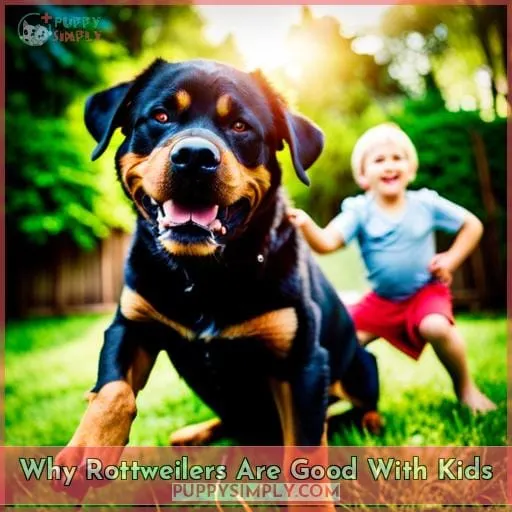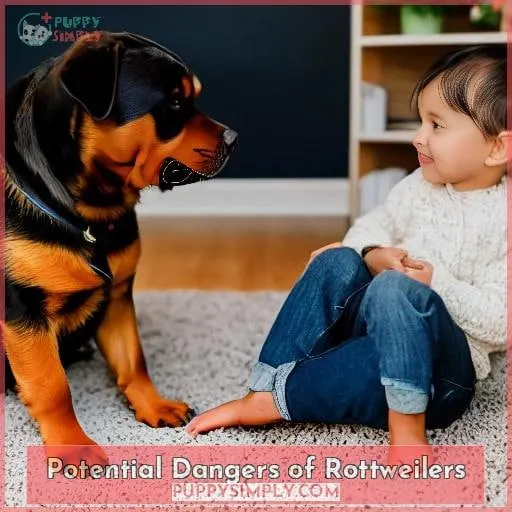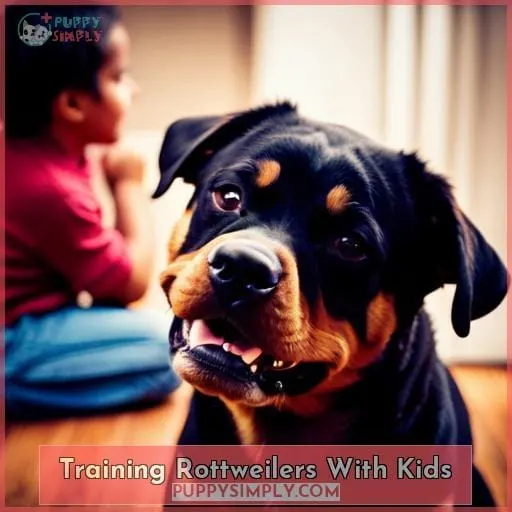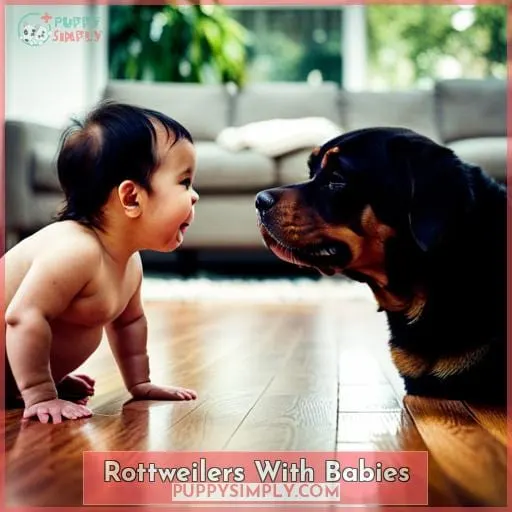This site is supported by our readers. We may earn a commission, at no cost to you, if you purchase through links.
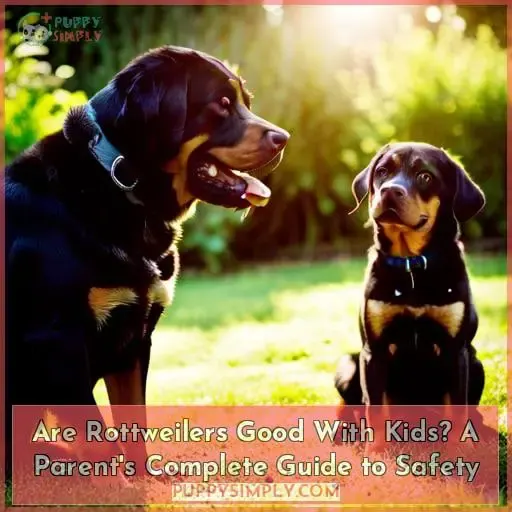 You want a safe, loving pet for your kids.
You want a safe, loving pet for your kids.
Consider the loyal Rottweiler.
With proper training, they make ideal family dogs – protective yet gentle, sturdy yet calm.
Research breed traits and match puppies’ energy to yours.
Supervise young kids, emphasizing respect.
Ultimately, any breed can thrive with compassionate leadership.
Invest time, and both children and Rottweilers will reward your family with devotion.
Table Of Contents
- Key Takeaways
- Rottweiler’s Best Qualities for Kids
- Why Rottweilers Are Good With Kids
- Potential Dangers of Rottweilers
- Training Rottweilers With Kids
- Rottweilers With Babies
- Rottweiler Breed Suitability
- Choosing the Right Size Dog
- Finding the Best Breed
- Frequently Asked Questions (FAQs)
- How do I introduce a new baby to my Rottweiler?
- What types of toys and games are best for Rottweilers to play with kids?
- Should I supervise my Rottweiler when interacting with neighbor kids or kids at the park?
- How can I teach my kids to properly walk, feed, and give commands to our Rottweiler?
- What steps should I take if my Rottweiler shows signs of resource guarding around my children?
- Conclusion
Key Takeaways
- Rottweilers can form tight bonds with children when properly socialized and trained, enjoying playful time together.
- Their large size and strength mean Rottweilers could unintentionally hurt young kids, requiring supervision.
- Rottweilers should be obedience trained and kids taught how to appropriately interact to prevent possessive or dominant behavior issues.
- Choose a dog breed that matches your family’s lifestyle and energy level, arranging meet-and-greets to evaluate each dog’s individual temperament.
Rottweiler’s Best Qualities for Kids
Rottweilers can be calm, flexible dogs that understand emotions well, making them potentially great companions for kids in the home.
Known for their playful companionship and emotional understanding, Rottweilers form tight family bonds with children.
Their high obedience intelligence makes training enjoyable, allowing them to be gentle guardians.
With proper socialization and training, Rottweilers can be loyal, unwavering protectors who enjoy playful bonding time with kids.
Their durable builds let them tolerate rough play while their calm demeanors at home provide the flexibility kids need in canine companions.
Rottweilers have the capacity for deep devotion and gentle guardianship of children when obedience trained.
Why Rottweilers Are Good With Kids
As loyal and protective breeds, Rottweilers can make great companions for kids when properly trained.
Their sturdy builds allow them to tolerate rough play, and their guarding instincts motivate them to vigilantly watch over children.
Additionally, Rottweilers tend to be intelligent and obedient dogs, making training them to behave appropriately around children an achievable goal.
Loyal and Protective
With their loyal instincts to protect and guard children, you’re choosing a breed that’ll stay by their side as playful yet protective companions.
Ensure training success through:
- Supervised interactions
- Proper socialization
- Establishing yourself as the leader
Rottweilers can be wonderful family dogs when provided strong guidance to develop an unwavering yet discerning temperament around children.
Sturdy for Play
Rottweilers can put up with rough play due to their durable builds, making them suitable companions for energetic kids who may unintentionally get too rough during games.
As robust companionship built for active engagement, Rottweilers make stalwart playmates for vigorous, playful interaction with children.
Still, their size demands training and supervision even during the most boisterous, stalwart play sessions to ensure safety.
Obedient Guard Dogs
While Rottweilers can be loyal and protective companions for children when properly trained and supervised, their large size and potential dominance mean they require experienced owners who can dedicate ample time for socialization and obedience training.
I’d be cautious recommending them for first-time dog owners or families unable to meet these demands.
Potential Dangers of Rottweilers
As loyal and sweet-natured as Rottweilers can be, their large size and dominant nature present some risks when around children.
With their muscular builds and potential for possessive behavior, Rottweilers could unintentionally knock over or even bite kids.
That’s why proper training and supervision are so critical if you choose to bring one of these powerful guard dogs into your family.
Large Size
One potential danger with Rottweilers is their large size.
As sturdy dogs, they can unintentionally hurt or knock over young kids.
Consider the following when it comes to size and safety:
- Rottweilers are big dogs.
- Their size matters when around small kids.
- Make sure your home fits a large breed.
- Prioritize training for safety based on breed type.
Dominant Nature
The dominant personality that some Rottweilers possess, especially intact males, requires you to establish yourself as a firm and consistent pack leader right from the start.
Use leadership training and dominance handling to set clear behavioral boundaries.
Employ positive reinforcement and thorough socialization techniques early on to nurture a sweet and trainable temperament in your Rottweiler while ensuring safety around kids.
Training Rottweilers With Kids
When bringing a Rottweiler into a home with children, proper training is imperative for everyone’s safety and happiness.
Make sure to socialize your Rottweiler with people of all ages, and enroll them in obedience training to master basic commands.
You’ll also need to teach kids how to appropriately interact with the dog, supervise all play sessions, and exercise the Rottweiler before interactions to prevent accidents.
Socialization
You’ll need to socialize your Rottweiler with people and kids of all ages as early as possible.
This includes activities like:
- Playdates with friends’ gentle, vaccinated dogs.
- Visits to dog-friendly stores and outdoor spaces.
- Positive interactions with children and adults.
- Puppy kindergarten and training classes.
Early socialization builds good canine manners and confidence around people.
Obedience Training
You must train your Rottweiler in basic obedience commands like sit, stay, come, heel, and leave it to ensure safe interactions with children.
| Command | Definition | Method |
|---|
Sit
Stay
Come
Heel
Leave it
Consistency, positive rewards, and socialization cement good behaviors for kid safety.
Supervising Play
One essential thing for training Rottweilers with kids is carefully supervising all play interactions between them.
You’ll want to actively monitor their play at all times to ensure safe and positive experiences for both the dog and children.
During playtime dynamics:
- Set clear interaction guidelines.
- Employ key safety measures.
- Orchestrate engaging activities.
- Maintain constant vigilance while supervising play between Rottweilers and kids for safety and effective training.
Rottweilers With Babies
With babies initially requiring extra caution around Rottweilers, you’ll want supervised interactions while establishing trust between your protective pup and tiny human.
Take it slow, keeping your Rottweiler leashed and allowing only brief sniffing.
As your baby becomes more interactive, continue bonding through treats, petting, and play.
Wait until your child is walking and talking before leaving them alone.
Socialize your puppy early and introduce basic obedience commands.
Ensure your Rottweiler sees your child as family to protect, not prey to herd.
With time, training, and supervision, a Rottweiler’s loyalty and calm can make them ideal companions for kids of all ages.
Rottweiler Breed Suitability
The suitability of Rottweilers for families with kids requires experienced ownership and adequate training time devoted to these dogs’ needs.
Evaluate each dog’s individual temperament and behavior around children during adoption meetings.
Allow supervised interaction between kids and potential Rottweilers to analyze their bonds.
Consider your family’s dynamics and ability to properly train and fulfill a Rottweiler’s needs.
While Rottweilers can be loyal and sweet-natured with kids when properly trained and socialized, take safety measures through temperament evaluation and behavioral analysis before adopting.
Providing your Rottweiler with structure, affection, training, and outlets for their energy promotes their good behavior around children.
With preparation and care, Rottweilers’ protective loyalty can provide kids with a lifelong canine companion.
Choosing the Right Size Dog
When choosing a dog for your family, consider your home size and your family’s lifestyle.
Match the dog’s energy level to yours – an inactive family may prefer a mellower small dog, while active families often enjoy larger, energetic breeds.
Do your research on different breeds to find one whose traits fit your family’s needs.
Consider Home Size
Your home’s size is an important factor when choosing the right dog for your family.
You’ll need to consider whether a small or large dog is better suited to your living space and lifestyle.
- Measure your home’s square footage and layout to determine space utilization.
- Consider your household size and how a dog may impact spatial considerations.
- Assess if your home environment can accommodate a large or small dog’s needs.
- Optimize space by selecting a dog size compatible with your home’s dimensions.
Match Energy Levels
But match their energy levels.
An active family may need a high-energy dog that can keep up, while a high-energy dog left alone for long periods could get bored and destructive.
To ensure playtime harmony and shared hobbies, consider your family’s activity levels when selecting a canine companion.
Seek energy compatibility and align your stamina by matching a dog to your lifestyle.
Selecting a breed whose energy aligns with your activities fosters compatibility.
Research Breed Traits
You’ll also want to thoroughly research breed traits before selecting the right dog for your family:
Arrange to meet potential breeds in person to evaluate temperament.
Analyze typical behaviors of breeds to ensure a good match.
Observe child interaction with breeds to gauge reactions.
Seek guidance from parents with experience owning breeds with children.
Thorough research and evaluation will help determine if a breed’s traits align with your family’s needs.
Socialization techniques can further shape good behaviors.
But know that inherent breed tendencies remain.
Finding the Best Breed
Frequently, you’re choosing the best breed by researching different dog breeds and considering your family’s unique needs and lifestyle.
When assessing breed compatibility, evaluate:
- Your family dynamics
- Living environment
- Activity levels
- Ability to properly train a dog
Schedule meetings with reputable breeders and shelters to interact with potential breeds and evaluate temperament.
Carefully observe how calm, friendly, energetic, and trainable each dog is, particularly around children.
The ideal family dog has:
- An affectionate yet obedient temperament
- Moderate energy levels
- Strong compatibility with kids
Choose a breed that:
- Your lifestyle allows you to properly care for
- Your children can form a safe, loving bond with
| Breed Factors | Description |
|---|---|
| Temperament | Affectionate, gentle, eager to please |
| Energy Level | Moderate energy for family life |
| Trainability | Responsive, focused, obedient |
| Kid Friendliness | Extremely child-friendly, caring |
| Size | Usually medium or large |
Frequently Asked Questions (FAQs)
How do I introduce a new baby to my Rottweiler?
Introduce your baby slowly and calmly.
Have another family member hold the baby while you walk the Rottweiler on a leash, letting it smell the new family member.
Reward calm behavior from a distance at first.
Over multiple supervised sessions, allow the Rottweiler to approach while the baby is held, until it reliably shows gentle curiosity.
Never leave them alone.
What types of toys and games are best for Rottweilers to play with kids?
When choosing toys, opt for rope toys or rubber balls that are large enough not to be choking hazards.
Games like fetch allow for active play while maintaining a safe distance between dog and child.
Provide plenty of appropriate chew toys to prevent the Rottweiler from getting bored and destructive.
Supervise all interactions, even during play, and teach the dog to release toys on command.
Should I supervise my Rottweiler when interacting with neighbor kids or kids at the park?
Yes, you should always supervise interactions between your Rottweiler and any children.
Even if your dog is well-trained, its size and strength pose risks.
Monitor play, enforce boundaries, and step in if your Rottweiler seems uneasy.
Their safety depends on your watchful eye.
How can I teach my kids to properly walk, feed, and give commands to our Rottweiler?
Walk alongside them, giving commands first, then treats for compliance.
Let them portion and carry the food under your watch.
Guide gently with leash pressure versus pulling or yelling.
Patience and teamwork build trust in this powerful breed.
What steps should I take if my Rottweiler shows signs of resource guarding around my children?
If your Rottweiler resource guards around children, immediately consult a professional trainer.
Carefully manage all high-value items, keeping children at a safe distance.
Reward non-possessive behaviors generously.
Stay alert, as resource guarding can escalate quickly.
Never punish or forcibly take items from the dog.
Instead, build trust through structured training.
Conclusion
Like a shepherd guiding his flock, wise parents can lead even a powerful Rottweiler to become a gentle guardian.
With dedicated socialization, training tailored to their breed traits, and constant supervision around children, these imposing yet devoted dogs will reward your family’s leadership with protection, playfulness, and years of affection.
Ultimately, when conscientious guidance and breed-specific care align, Rottweilers and kids can thrive together.


